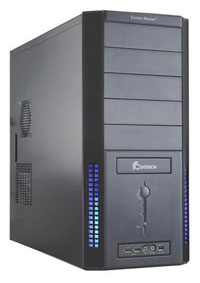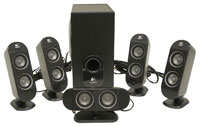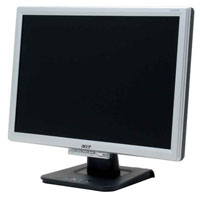Basic Configuration - Accessories
All of the components we've discussed so far tend to have more of an impact on overall system performance. What remains are the miscellaneous accessories that may not impact performance at all, but they do influence other areas of the computing environment. Personal preference will play a larger role in many of these components, so as always we would recommend people stick with what they like first and only branch out if you are looking to try something else. Most of the base selections can be used with any of the builds we will be putting together without any difficulty, and we will try to make note of any exceptions.
For optical storage, Blu-Ray and HD-DVD are still too expensive to warrant inclusion in a midrange computer, so we return to the venerable DVD+RW. Most companies now offer 18X burn speeds, which are barely faster than the old 16X maximum, and street prices bottom out at around $30. The LG GSAH22N includes all the standard features as well as 12X DVD-RAM support and works well with a variety of media, so it gets our recommendation. We're still waiting for reasonably priced SATA optical drives that can deliver similar overall quality, unfortunately.
 |
The computer case is one of the items that you will see a lot, but you really only have to work with it once or twice during the life of the typical computer (unless you upgrade frequently). Appearance is definitely an important consideration for many people, and what one person finds attractive another will find ugly or boring. Besides the appearance, the choice of case will also impact noise levels, cooling, and ease of installation. The cheapest cases tend to be made of thin steel, which gives them sharp edges internally and also makes them pretty flimsy. They will still suffice for most people, but we prefer slightly more expensive cases. Cooler Master has a large selection of reasonable midrange cases, and most of us find them to be easy to work with and reasonably attractive. Antec, In Win, Thermaltake, Apevia, Lian Li, and others offer alternatives worth considering, and if you are more budget minded the Rosewill brand is worth a look. We like cases that support 120mm fans (at least one) as they will typically offer better cooling with lower noise levels. Beyond that, remember to make sure your optical drive matches whatever case you choose.
 |
Of far more concern than the case is going to be the power supply you use, particularly in some of the upgraded midrange configurations. Getting a case with an included power supply will usually save you some money, and most power supplies rated at 350W or higher are sufficient for a midrange computer. Still, when you consider that you're spending over $1000 on all of the other components, we really hesitate to shave $40 or $50 off the total price by sticking with a low-end power supply. We've selected a reasonably priced 450W Fortron Source PSU as our basic recommendation, and that should be more than enough for any midrange computer, other than for serious overclocking. Fortron Source is a well-regarded PSU manufacturer, and they are often used as the basis of OEM power supplies. The only potential drawback of the AX450-PN is that it only has a 70% efficiency rating, but if you want a higher efficiency power supply you will have to spend more money. We're more concerned about power supply noise levels than efficiency, and while the two are related the 120mm fan used in the FSP helps to keep noise levels down. If you're willing to spend a bit more money and you want the best of both worlds - quiet and efficient - SeaSonic gets a strong recommendation. They tend to cost more for lower wattage ratings, but a SeaSonic S12-330 performs better than most other 400-450W power supplies. OCZ, Enermax, and several other companies also make some very good high-end power supplies, which we will discuss a bit further in the overclocking configuration, but SeaSonic remains one of the quietest (short of purchasing a fanless PSU).
 |
Keyboard, mouse, and speakers are three items where you can either go for the bare minimum cost and functionality, or you can spend a lot of money for extra features. We have selected what we feel are good options for all three areas, and it would be hard to find anything that's truly "better" without spending more money. Our performance configuration will include better speakers, but we didn't feel the need to upgrade the keyboard or mouse on any of the builds. If you want to get a wireless keyboard and mouse, our advice is to spend more money rather than less. The $30-$40 packages generally don't perform as well as we would like, so unless you absolutely want wireless input devices, we prefer to spend the extra money elsewhere.
 |
The last accessory is the display, and as we have said on many occasions we would much rather have a very nice display with a decent computer than to have an excellent computer with a lousy display. LCD prices have continued to drop, although even the cheapest 19" models still tend to cost just under $200. The 19" LCDs are still a good option, but for the extra money we would prefer to get a 20" LCD that comes with a higher resolution. Most of us also prefer widescreen LCDs these days, and although there are a few gaming titles that continue to cause irritation by not natively supporting widescreen resolutions, moving forward WS support should become commonplace. Outside of games, watching widescreen movies is definitely preferred, and we enjoy the extra screen width on the Windows desktop as well. Looking at the various 20" widescreen displays that are available, Acer once again has one of the best price/performance offerings. ViewSonic, BenQ, Samsung, and several other companies make similar LCDs, but they all cost a bit more and it is difficult to say that they actually look much better than the Acer model. For $230, most people will be very happy with the Acer AL2016W.
For the operating system, we selected Windows XP Media Center Edition 2005. It only costs slightly more than XP Home, and it allows you to upgrade to Vista Home Premium as we mentioned earlier. The DVR functionality may not be necessary, but it doesn't hurt either, and the only features that XP Pro adds (i.e. hard drive encryption) are not used by most people.














43 Comments
View All Comments
KorruptioN - Friday, January 19, 2007 - link
That 500W unit is built by ATNG, the 600W PSU in the guide comes from Solytech/Deer. Two completely different OEMs. ATNG is still not regarded very highly around the Internets, but they're working on it.As for the number of DOAs being higher (which may indeed be true), what happens when the entire computer is taken out by a faulty PSU that fails catastrophically on it's secondary side? Sure they'll give you a new power supply, but you'll still be out of a functioning computer.
Operandi - Friday, January 19, 2007 - link
Rosewill has many OEMs for it's units.That unit reviewed by Jonny Guru has absolutely no bearing on the unit recomended in the article. One good Rosewill unit doesn't make the rest of them so. The only thing that matters is how the unit is built, not the sticker on the outside.
crydee - Friday, January 19, 2007 - link
I would of recommended the Corsair HX-520 for the mid-range overclocking guide it's cheaper and performs awesome. You guys saw the 620W version take on 2 8800GTXs >_<